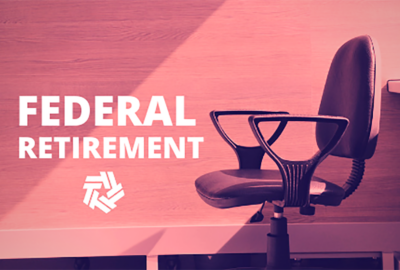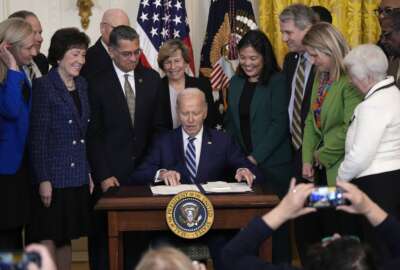The leaves are drying already — so it’s time to think about end-of-year retirement
The end of July isn't the end of summer — but the drying leaves mean autumn, and time to think about end-of-year retirement planning.
The end of July isn’t the end of summer — but the leaves are dryer and the cicadas louder. That means autumn, and time to think about end-of-year retirement planning. Here on the Federal Drive with Tom Temin with some tips to think about, federal retirement expert Tammy Flanagan.
Interview transcript:
Tom Temin The end of July isn’t the end of summer, but the leaves are drier, the cicadas louder. That means autumn and time to think about the end of year retirement planning. Here with some tips to think about specifically, federal retirement expert Tammy Flanagan. And, golly, if you’re planning to retire in December, here it is, nearly August. You really gotta be on the ball at this point.
Tammy Flanagan Exactly. Yeah, I guess the planning really should have started, you know, a long time ago. But when you’re really ready to set the date and turn in your application, some people think, well, I could wake up on Monday and just call in and say that was my last day on Friday. But if you do that, you’re going to wait longer for your all your benefits to come into play. So, it’s always a good idea to look over the applications. Make sure you have all the documents that you need to attach. Make sure you understand what the questions are on the application, because there are some important decisions you have to make. And then when it is time to turn in the application, talk to your HR specialist, and they can tell you how much notice they need, because it can be anywhere from 30 days for a small agency to as much as six months for a really large organization, because they’re going to get a lot of retirements at the end of the year, especially in those larger organizations. So, you want to be at the top of the queue when they start working on those end of the year applications. You know, you want yours to be right up there.
Tom Temin It’s also more professional, isn’t it, in some sense, to give people good, solid notice of your retirement, if you care about the organization?
Tammy Flanagan Yeah, you would think so. I remember when I worked at the FBI. This was years and years ago, but I would have applications be under my door in a sealed envelope with private, secret, you know, don’t tell anybody I’m leaving. Because I think once the office knows that you’re on the way out, you know, they treat you a little differently, perhaps. But you know, definitely tell your supervisor you’re leaving and give HR some notice, because they’ve got some work to do.
Tom Temin All right, so you submit your retirement application to HR. What about your supervisor? What rule do they have?
Tammy Flanagan It depends on the agency. Some agencies will say, you know, we need 60 days notice. You know, you know in your position how long it’s going to take to hire a replacement to train them, perhaps. So, you want to give them some courtesy that way. But I don’t know that there’s any law or hard and fast rule that you have to give that notice.
Tom Temin And processing of the retirement claim. That varies, I guess, by season, by year. What are we looking at these days from OPM?
Tammy Flanagan Yeah, it does vary. It varies based on a lot of different places along the way of the application, beginning with you. So, whenever you fill out the application form, make sure you answer every question. Make sure you answer it correctly. I had one guy who told OPM, by answering a question, it was a yes or no question, do you get a military retirement? And he said yes. And then they said, Are you going to waive it? And he said no, but he had a reserve retirement. He doesn’t have to waive it, and based on the answer that he put on his application, OPM gave him a hard time about giving him credit for his active duty time while he served in the reserves, which was really a long process to get corrected. So, be sure that you look that thing over, have maybe somebody else look it over with you. If you’re fortunate, you’ll have someone in HR that will go through it and make sure that you’ve dotted all the I’s and crossed all the T’s on that application. And then your HR has work to do. You know, they have to kind of take apart your personnel records, get your health benefits ready to transition, life insurance, and also all your personnel file. Your records of your personnel history have to match up with what you’ve done. So, if there’s any missing documentation, that right there can cause a major delay. And then it goes into payroll. You know, payroll has got to get you off the payroll. They’ve got to send the retirement contributions that you’ve paid to your agency, to OPM. And, so, depending on how long it takes them to do their processing, that can also be a delay. There have been some payroll offices that have delayed that by five or six months, which is incredibly long, in my opinion. It should really happen within 30 days. But, you know, it doesn’t always work that way.
Tom Temin Sure. And the more places you’ve worked, the more complicated your retirement calculation, and if you’ve left government, maybe, and come back, all of these things add complexity, and, therefore, time, to figuring out that final annuity.
Tammy Flanagan That can add time, but as long as everything’s documented appropriately, it shouldn’t be too difficult. What else can add time or things that can take longer to process, such as a court order. So, if you’ve gone through a divorce and your former spouse has been awarded a portion of your retirement or survivor benefits. It has to go to a whole nother office at OPM, the court ordered benefits branch, so that’s going to take longer if you’re retiring under special provisions, like law enforcement, firefighters, those have to go to a special branch to be processed by the specialist who does those types of applications. So, all these things can add up to a longer processing time. But that’s not to say that some people will have their first retirement check the month after they retire, although that’s pretty unusual. Usually takes on average, 90 days to process an application, that’s after OPM receives it. So, count on there being a bit of a wait, a transition period, so to speak, while you’re getting ready to start getting those checks in the bank every month.
Tom Temin We’re speaking with Tammy Flanagan. She’s a principal at Retire Federal and knows about these things from many years’ experience. And sick leave, annual leave. If you retire at the end of the year and, say, you haven’t taken a vacation, you get all that at that point?
Tammy Flanagan Yeah, so, your annual leave, whatever you’ve carried over from last year, whatever you’ve accumulated and haven’t used this year, whatever hours you have, which could be as much as, for many employees, up to 448 hours or more, if you have a higher carryover limit, that all gets paid to you in a lump sum. And, again, that’s not coming from OPM, that’s coming from your payroll office. So, hopefully it’s going to come within a few pay periods after your retirement, and that should help tide you over while you’re waiting for those regular retirement checks to come in from OPM, because it can be a pretty substantial check for someone who has a lot of hours of unused leave at the end of their career. Now, your sick leave, that’s going to be converted to time. So, if you have, let’s say, 1,000 hours of sick leave left on the books, that’s going to give you another six months or so credit to your retirement calculation, which translates to about a half a percent of your high three for the rest of your life. So, there is some monetary value to your sick leave as well.
Tom Temin Interesting. And this is not all a secret. I mean, OPM publishes lots of information for would-be retirees.
Tammy Flanagan Absolutely. They’ve recently come out, this year it was updated, they call it a retirement quick guide. And it does give you some really helpful hints about things you should do before you retire, understanding these choices about survivor benefits, naming a beneficiary, continuation of health and life insurance. So, if nothing else, you know, review this. It’s a three-page guide. It doesn’t take you too long to go through it, and if you look at it online, it’ll give you some links to some of these areas that you might have additional questions on. So, that’s a good place to start, especially if you’re someone who doesn’t have a local HR specialist to help you through the process. You know, look at the information that it is on OPM website, because you’ll find it to be pretty useful.
Tom Temin All right. Well, that’s good advice. And speaking of retirement, people will eventually be withdrawing from their TSP and now there is a new L fund.
Tammy Flanagan There is a brand new L fund, but it’s not for the people getting ready to retire in most cases. It’s the L 2070 fund. Can you believe that, L 2070? And this is based on people who were born in 19, let’s see, not 19. I think 2000, because somebody was born in the year 2000, believe it or not, they could be working for the government right now, and they’d be 24 years old, and that L 2070 fund might be about the target date for their retirement years. So, this is probably for our youngest hires that’s coming on board. But it’s going to be a really aggressive fund. It’s going to be almost 100% stocks, and it will gradually shift to the more conservative mix of investments by the year 2070, but for many years to come, you’re going to have the advantage of the fluctuations of the stock market, which is volatility, but that volatility can generally result in an upward trajectory of those compound interest rates, which you want early on in your career. You can afford the risk, because you have plenty of time to to overcome a downturn. So, that’s a new fund. And, of course, next year, the L 2025 fund will disappear. It’s not going to disappear entirely. It’s going to be rolled into the L Income Fund, which is the most conservative mix, you know, just the opposite of the 2070 fund. It’s mostly G and F Fund, and really, mostly G, and very little, maybe, I think it’s maybe 20%, 15% stocks in that L Income Fund.
Tom Temin So the L fund, then, a given L fund series, starts out as an aggressive investment vehicle, and over time, it sort of devolves as the wave settles down into mostly G fund.
Tammy Flanagan It does. It does, and that’s that’s to eliminate someone from having to make those decisions about, when do I reallocate? You know, how much should I have in the C fund or the S fund? This kind of makes that decision for you based on a professional mix of investments, based on your time horizon. Now, some financial planners might say it’s maybe too conservative, even as it is. And if you were working with a financial professional and you didn’t have money in just these five funds, you might have a more broad mix of diversified investments. But like I’ve talked to many financial advisors who say, this is certainly better than trying to do it yourself and not really knowing how to do it, because I’ve seen all kinds of things. I’ve seen people with, you know, 10% in the G, 50% in the L 2050, 20% in the C fund. You know, they’re just mixing it up because they really don’t know what to do. And these L funds were really designed to be 100%. Put everything in that l fund and then just let it go and keep adding to it. And I think you’ll end up in pretty good shape.
Tom Temin Right, so someone could, if they, for some reason, wanted to, could be in their 50s and buy into the L 2070 if that was their choice, that’s available, too.
Tammy Flanagan They’re open to everyone. Yep, they sure are.
Tom Temin So, you could keep going with the latest L fund throughout your life, if you really like that thrill of how front end loaded it is with pure stocks and never get to the G part of it, if you keep going from L 25 to L 30, 40, 50, whatever they are, right?
Tammy Flanagan And if you’re someone who really doesn’t need to use your TSP account when you retire, because we do have a lot of people who retire in their 50s who might be going on to work someplace else, or do some consulting where they’re really not going to be using that thrift plan right away. Then pick a longer date horizon, because you want to stay invested as long as possible to take advantage of those stock market gains when they come about.
Tom Temin All right. Anything else people need to know about year end retiring, other than the fact that you don’t have much time?
Tammy Flanagan Yeah, that’s true. One other thing with the Thrift though, is they are introducing a new I fund, but it’s kind of a stealth I fund, because if they just put it into play, you know, and they announced it ahead of time, there might be some inadvertent trading in the markets that would affect the whole I fund situation. So the I Fund has always been the Europe, Australasian, the Far East Fund, which is a fairly small group of large company stocks overseas, and it doesn’t include emerging markets. It doesn’t include Canadian stock. So, over the course of 2024 and no later than December 31, all of the existing I fund that’s in the E fund is being transitioned into a new I fund, which is going to be the USA, I mean, the world MSCI, I should say, World Index, except China, Hong Kong and the U.S. So, that’s the name of the fund that they’re using. So, I was looking at the returns of that fund over the past year, five years and so forth, and I’m seeing that it’s tracking pretty close to our existing I fund, maybe a little bit higher. For example, over the course of the last one year period, the existing fund returned 11.72% over that one year, and this new fund returned 13.2, so it’s an increase of 1.48% over a year, which is pretty close. You know, it’s not going to be a big, big difference, but it is going to expose you to many other companies, you know, thousands as opposed to hundreds.
Tom Temin All right. Well, good advice to know and know that it’s you know, meets that requirement of not being in China, which I think, pretty much as everybody’s bought into at this point. Tammy Flanagan is a principal at Retire Federal. As always, thanks so much.
Tammy Flanagan Thanks, Tom. Good to see you again.
Tom Temin And we’ll post this interview along with a link to more information about that new L Fund at federalnewsnetwork.com/federaldrive. Subscribe to the Federal Drive, wherever you get your podcasts.
Copyright © 2025 Federal News Network. All rights reserved. This website is not intended for users located within the European Economic Area.
Tom Temin is host of the Federal Drive and has been providing insight on federal technology and management issues for more than 30 years.
Follow @tteminWFED






